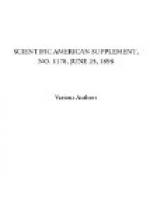COMBINATION CLAIMS.
Many people have an erroneous notion regarding patent claims, and consider the expression “combination” as an element of weakness. The fact is, that all mechanical claims that are good for anything are combination claims. No claim for an individual mechanical element has come under my notice for many years and I doubt if a new mechanical element has been lately invented. All claims resolve themselves into combinations, whether so expressed or not. Combination does not necessarily imply separateness of elements. The improved carpet tack is after all but a peculiar combination of body and head and barbs. The erroneous public contempt for combination claims is based upon the legal maxim, that if you break the combination you avoid the claim and escape infringement, and this legal maxim should be well understood in formulating the claims. If the claim calls for five elements and the competitor can omit one of the elements, he escapes infringement. Therefore, the claim is good only when it recites no elements which are not essential.
Many inventors labor under the delusion that a claim is strong in proportion to the extent of its array of elements. The exact opposite is the truth, and that claim is the strongest which recites the fewest number of elements. It is the duty of the inventor to analyze his invention and know what is and what is not essential to its realization. It is the duty of the patent solicitor to sift out the essential from the non-essential, and to draft claims covering broad combinations involving only essential elements. Sometimes the inventor will help him in this matter, but quite as often he will, through ignorance, hinder him and combat him. The invention having been carefully analyzed and reduced to its prime factors, and the claim having been provided to comprise a combination involving no element which is not essential to a realization of the invention, a new and more important question arises. The elements have been recited in terms fitted to the example of the invention thus far developed. The combination is broadly stated, but the terms of the elements are limiting. Cannot some ingenious infringer realize the invention by a similar combination escaping the literalism of the terms of the elements? It is at this stage that the claim must be carefully studied. The inventor, or some one for him, must assume the position of a pirate, and set his wits to work to contrive an organization realizing the invention but escaping the terms of the proposed claim. When such an escaping device is schemed out, then the defect in the claim is developed and the claim must be redrawn. In this way every possible escape must be studied so as to secure to the inventor adequate protection for his invention. Solicitors find it difficult to get inventors to do or consider this matter properly, inventors being too often inclined to disparage alternative constructions, the matter being largely one of sentiment founded on the love of offspring.




